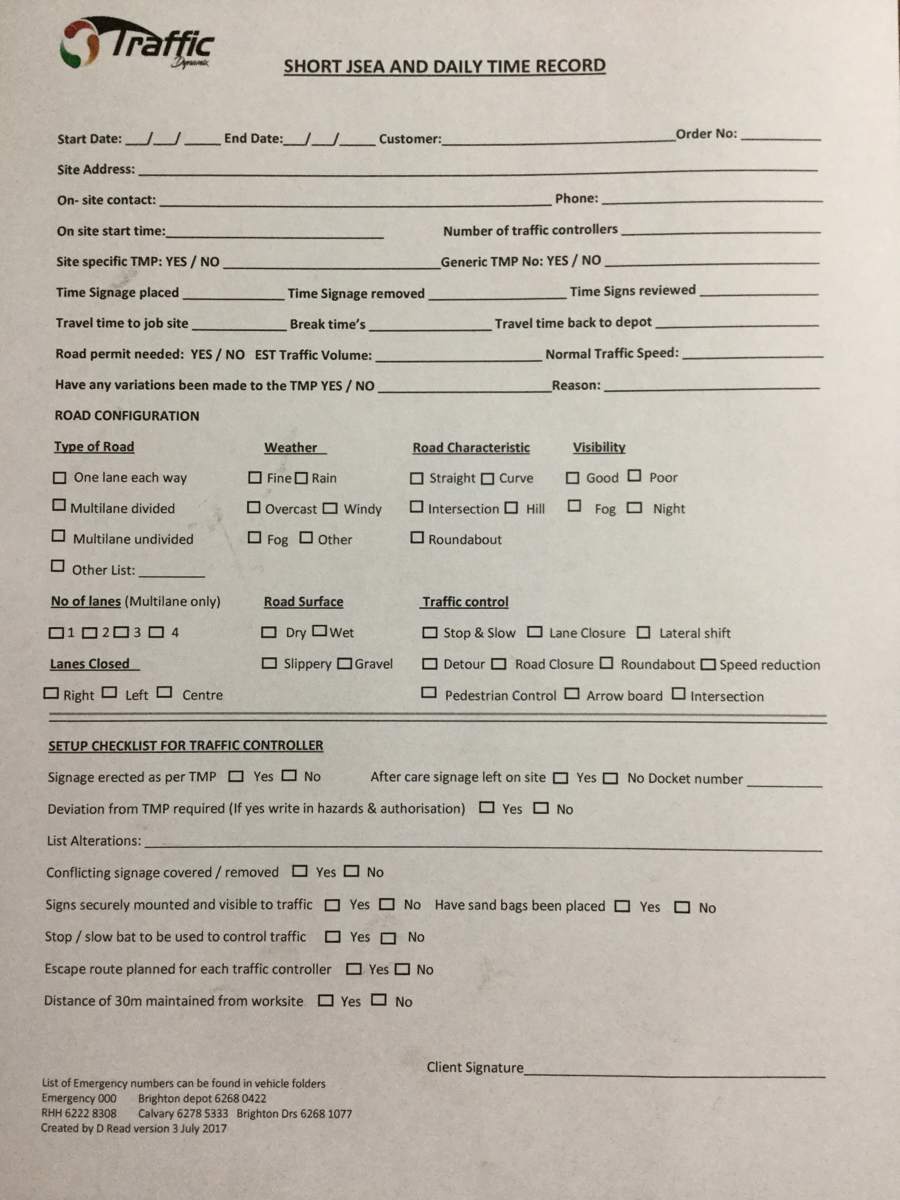Title Page
-
Document No.
-
Client / Site
-
Location
-
Conducted on
-
Prepared by
-
Additional Personnel
Arriving on site
Common hazards
-
Aware of site safety requirements e.g. PPE to be won on site
-
Aware of site traffic requirements
-
Aware of where to locate equipment
-
Aware of where to drop off or pick up equipment
-
Fit for work
-
Permit for work required?
Control measures
-
Report to site office to get directions
-
Report to site supervisor
-
Report to site personnel
-
Accurate directions supplied from transport controller, hire office or service controller
-
Attended site induction
-
Escorted around site by site personnel
-
Do not need to enter site
-
Where required, Permit to work issued by site supervisor
-
Ensure adequate rest period has been taken between shifts
-
Not effected by alcohol or drugs (as per Coates Alcohol and Drug Policy)
Is the job site safe?
-
Yes
Collision or interaction with traffic/equipment/pedestrian/other workers
Common hazards
-
Roadways
-
Vehicles or cyclists
-
Public walkways
-
Pedestrians or general public in the area
-
Other workers in the area
-
Equipment working in the area
-
Blind corners
-
Positioning of moving vehicle/ crane/ equipment
-
Railway/ tram lines/ crossings
-
Aircraft/ runways
-
Shipping/ wharf activites
-
Other
Control measures
-
Physical barriers
-
Qualified traffic controller
-
Traffic signs
-
Physical separation of activites
-
Roadwork/ warning signage
-
Traffic control plan
-
Barrier mesh/ tape/ bunting
-
Witches hats
-
Use a spotter when moving vehicle/ crane/ equipment, especially when reversing
-
Persons stay in safety zones during loading
-
Travel speed maximum 10km/h or per site conditions
-
Engage rotating beacon
-
Engage hazard warning lights
-
Motion/ reversing alam
-
Ensure only essential personnel are in the work area
-
Other
Is the job site safe?
-
Yes
Site environmental condition
Common hazards
-
Stable, even, non-slippery ground surfaces
-
Site housekeeping
-
Wet or waterlogged ground conditions
-
Waterways/ drainage nearby
-
Trenches/ backfilled nearby
-
Trees/ flora
-
Buildings
-
Onsite facilities/ structures or equipment
-
Bridges
-
Other overhead obstruction
-
Other
Control Measures
-
Ground conditions assessed by competent person
-
Vehicle/ crane/ equipment is on FIRM LEVEL ground
-
Fully extend outriggers on cranes or equipment where fitted
-
Suitable packing is to be used under outriggers/ stabilisers
-
Set up a crane/ equipment's nearest outrigger to the trench, as far away from the trench as the trench is deep
-
Ensure adequate distance/ protection is maintained for all onsite facilties, structures or equipment
-
Relocate position of crane or equipment if necessary
-
Use a tag line
-
Use a spotter
-
Obtain authority to trim trees/ flora if trimming is required
-
Use trak mats
-
Advise site supervisor of site housekeeping issues that will affect the job
-
Wear suitable protective footwear/ clothing
-
Other
Is the job site safe?
-
Yes
Services or powerlines
Look up and Live. Common hazards
-
Locate power lines
-
Overheard services
-
Live Aerial conductors (power lines)
-
Gas Transmission Lines
-
Above ground pipes
-
Installing Earth stakes for portable generators
-
Other
Control measures
-
Locate power lines
-
Locate and mark all services
-
Maintain safe working distance
-
Observe no go restrictions
-
Use a QUALIFIED spotter
-
Contact authorities and isolate power if necessary
-
Ring "Dial Before You Dig" 1100
-
Obtain approval for work in Gas Transmission pipeline areas
-
Relocate task to another area
-
Other
Is the job site safe?
-
Yes
Weather/visibility
Common hazards
-
Windy or stormy conditions
-
Electrical storm/ heavy rain
-
Extreme heat
-
Poor visibility, night work
-
Extreme cold/ icy conditions
-
Other
Control Measures
-
Do not operate equipment or cranes during an electrical storm or heavy rain
-
Do not operate EWP's or cranes if wind speed exceeds wind speed rating
-
Use a tag line when lifting a load with a crane
-
Install artifical lighting if working at night or in dark conditions
-
Wet weather clothing
-
Postpone all work until suitable conditions are present
-
Ensure hydration levels are maintained to safe working level
-
Take appropriate breaks if required
-
Sun protection e.g. hat and sunscreen
-
Wear adequate clothing during cold/ icy conditions
-
Wear adequate footwear
-
Other
Is job site safe?
-
Yes
Working at heights
Common Hazards
-
Edge protection
-
Working from a ladder
-
Working above 2 metres
-
Operating a boom lift
-
Risk of a fall
-
Climbing on to equipment
-
Other
Control Measures
-
Maintain 3 points of contact when working with a ladder
-
Ensure ladders are adequately secured both top and bottom
-
Use a person to assist in securing a ladder
-
Use a work platform
-
Use an EWP
-
Pre sling loads
-
Ensure all surfaces are non slip and there is no risk of a fall
-
Do not go within a 2m distance of an unprotected edge
-
Wear a harness when operating an EWP
-
Employ fall arrest equipment when working from heights
-
Ensure surface is not fragile or unstable
-
Other
Is the job site safe?
-
Yes
Confined spaces
Common Hazards
-
Have identified a confined space
-
Required to enter confined space
-
Other
Control Measures
-
Assess site for confined spaces
-
Suitably trained and qualified to enter a confined space
-
Suitably equipped to enter a confined space
-
Have obtained a confined space entry permit
-
Other
Is the job site safe?
-
Yes
Personal or physical protection
Common Hazards
-
PPE required to perform task
-
PPE in bold print MANDATORY for dogging and personnel in loading/unloading area
-
Task involve manual handling
-
Other
Control Measures
-
Hard hat
-
Hand protection
-
Eye protection
-
Protective clothing & hi vis garments
-
Fire resistant clothing (petrochemical plants)
-
Appropriate safety footwear
-
Hearing protection
-
Respiratory protection
-
Never lift more than 20kg
-
Use mechanical lifting aids
-
Site PPE requirements observed
-
Have adhered to Coates Hire PPE policies
Is the job site safe?
-
Yes
Own use equipment
Common Hazards
-
Need to conduct an inspection of equipment
-
Need to use hand tools
-
Need to use electrical equipment
-
Other
Control measures
-
Daily inspection of equipment/cranes and lifting gear has occured
-
Daily inspection has been recorded in a log book
-
Hand tools are inspected before use
-
Electrical equipment is adequately tested and tagged
-
Other
Is the job site safe?
-
Yes
Finalisation
Only proceed if it safe to do so
-
Signature












